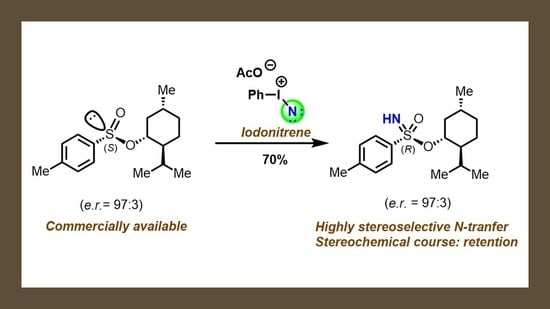(1R,2S,5R)-2-Isopropyl-5-methylcyclohexyl (R)-4-methylbenzenesulfonimidate
Abstract
1. Introduction
2. Results
3. Materials and Methods
- (1R,2S,5R)-2-Isopropyl-5-methylcyclohexyl (R)-4-methylbenzenesulfonimidate. To a solution of (1R,2S,5R)-2-isopropyl-5-methylcyclohexyl (S)-4-methylbenzenesulfinate (1 g, 3.4 mmol) in MeCN (17 mL), ammonium carbamate (1.06 g, 13.6 mmol, 4.0 equiv.) and diacetoxyiodobenzene (2.74 g, 8.5 mmol, 2.5 equiv.) were added in one portion, and the mixture was stirred at room temperature for 3 h. The solvent was evaporated under reduced pressure, then, 100 mL of NaHCO3 (aq.) solution was added and the mixture was extracted with 3 × 50 mL of AcOEt. The organic layers were collected, dried over Na2SO4, and the solvent was removed under reduced pressure. The reaction crude was purified by column chromatography on neutral alumina (Rf = 0.5, 20% AcOEt in hexane) to afford the desired product as a white waxy solid (740 mg, 70% yield). 1H NMR (300 MHz, CDCl3) δ 7.88 (d, J = 8.3 Hz, 2H, Ar–H), 7.29 (d, J = 8.2 Hz, 2H, Ar–H), 4.21 (td, J = 10.8, 4.5 Hz, 1H, CH), 3.14 (s, 1H, NH), 2.41 (s, 3H, CH3), 2.13–2.03 (m, 1H, CHH), 1.85 (dtd, J = 13.7, 6.8, 2.1 Hz, 1H, CH), 1.66–1.55 (m, 2H, 2 × CHH), 1.41–1.21 (m, 2H, 2 × CH), 1.15–1.08 (m, 1H, CHH), 0.94–0.76 (m, 7H), 0.39 (d, J = 6.9 Hz, 3H, CH3). 13C NMR (75 MHz, CDCl3) δ 143.7, 136.9, 129.5, 127.6, 82.2, 47.8, 42.4, 34.0, 31.8, 25.5, 23.1, 22.1, 21.6, 21.1, 15.3. IR (KBr) = 3271, 2923, 2851, 1454, 1328, 1158, 1093, 814. HRMS (ESITOF) m/z (2M + Na)+ calcd for C34H54N2NaO4S2 641.3423; found 641.3416. [α]D20 = −45.8° (CDCl3, c 0.1).
Supplementary Materials
Author Contributions
Funding
Data Availability Statement
Acknowledgments
Conflicts of Interest
References
- Matos, P.M.; Stockman, R.A. Synthetic Approaches and Applications of Sulfonimidates. Org. Biomol. Chem. 2020, 18, 6429–6442. [Google Scholar] [CrossRef] [PubMed]
- Reggelin, M.; Weinberger, H. One-Pot Synthesis of (S)-4-Isopropyl-2-p-Toluene-4,5-Dihydro-[1,2λ6,3]Oxathiazole 2-Oxides: Efficient Precursors of Optically Active Sulfoximines. Tetrahedron Lett. 1992, 33, 6959–6962. [Google Scholar] [CrossRef]
- Matos, P.M.; Lewis, W.; Argent, S.P.; Moore, J.C.; Stockman, R.A. General Method for the Asymmetric Synthesis of N–H Sulfoximines via C–S Bond Formation. Org. Lett. 2020, 22, 2776–2780. [Google Scholar] [CrossRef] [PubMed]
- Bremerich, M.; Conrads, C.M.; Langletz, T.; Bolm, C. Additions to N-Sulfinylamines as an Approach for the Metal-free Synthesis of Sulfonimidamides: O-Benzotriazolyl Sulfonimidates as Activated Intermediates. Angew. Chem. Int. Ed. 2019, 58, 19014–19020. [Google Scholar] [CrossRef] [PubMed]
- Reggelin, M. New Stereocontrolled Synthesis of Cyclic Sulfonimidates. Tetrahedron Lett. 1995, 36, 5885–5886. [Google Scholar] [CrossRef]
- Jonsson, E.U.; Johnson, C.R. Chemistry of Sulfoxides and Related Compounds. XXXIII. Stereochemistry of Substitution at Tetracoordinate Hexavalent Sulfur. Nucleophilic Reactions at Sulfur in Sulfonimidoyl Compounds. J. Am. Chem. Soc. 1971, 93, 5308–5309. [Google Scholar] [CrossRef]
- Liang, D.; Streefkerk, D.E.; Jordaan, D.; Wagemakers, J.; Baggerman, J.; Zuilhof, H. Silicon-Free SuFEx Reactions of Sulfonimidoyl Fluorides: Scope, Enantioselectivity, and Mechanism. Angew. Chem. Int. Ed. 2020, 59, 7494–7500. [Google Scholar] [CrossRef] [PubMed]
- Briggs, E.L.; Tota, A.; Colella, M.; Degennaro, L.; Luisi, R.; Bull, J.A. Synthesis of Sulfonimidamides from Sulfenamides via an Alkoxy-amino-λ6-sulfanenitrile Intermediate. Angew. Chem. 2019, 58, 14303–14310. [Google Scholar] [CrossRef] [PubMed]
- Andresini, M.; Spennacchio, M.; Romanazzi, G.; Ciriaco, F.; Clarkson, G.; Degennaro, L.; Luisi, R. Synthesis of Sulfinamidines and Sulfinimidate Esters by Transfer of Nitrogen to Sulfenamides. Org. Lett. 2020, 22, 7129–7134. [Google Scholar] [CrossRef] [PubMed]
- Andresini, M.; Spennacchio, M.; Colella, M.; Losito, G.; Aramini, A.; Degennaro, L.; Luisi, R. Sulfinimidate Esters as an Electrophilic Sulfinimidoyl Motif Source: Synthesis of N-Protected Sulfilimines from Grignard Reagents. Org. Lett. 2021, 23, 6850–6854. [Google Scholar] [CrossRef] [PubMed]
- Tota, A.; Colella, M.; Carlucci, C.; Aramini, A.; Clarkson, G.; Degennaro, L.; Bull, J.A.; Luisi, R. N−N Bond Formation Using an Iodonitrene as an Umpolung of Ammonia: Straightforward and Chemoselective Synthesis of Hydrazinium Salts. Adv. Synth. Catal. 2021, 363, 194–199. [Google Scholar] [CrossRef]
- Andresini, M.; Colella, M.; Degennaro, L.; Luisi, R. For a recent review on the use of hypervalent iodine reagents for the chemoselective N-transfer. Arkivoc 2021, 2021, 141–163. [Google Scholar] [CrossRef]
- Tota, A.; St John-Campbell, S.; Briggs, E.L.; Estévez, G.O.; Afonso, M.; Degennaro, L.; Luisi, R.; Bull, J.A. Highly Chemoselective NH- and O-Transfer to Thiols Using Hypervalent Iodine Reagents: Synthesis of Sulfonimidates and Sulfonamides. Org. Lett. 2018, 20, 2599–2602. [Google Scholar] [CrossRef] [PubMed]
- Hedouin, G.; Dherbassy, Q.; Wencel-Delord, J.; Colobert, F. An Improvement of the Synthesis of (1R,2S,5R)-(–)-Menthyl (S)-p-Toluenesulfinate. SynOpen 2021, 5, 65–67. [Google Scholar] [CrossRef]
- Degennaro, L.; Tota, A.; De Angelis, S.; Andresini, M.; Cardellicchio, C.; Capozzi, M.A.; Romanazzi, G.; Luisi, R. A Convenient, Mild, and Green Synthesis of NH-Sulfoximines in Flow Reactors. Eur. J. Org. Chem. 2017, 2017, 6486–6490. [Google Scholar] [CrossRef]
- Zenzola, M.; Doran, R.; Degennaro, L.; Luisi, R.; Bull, J.A. Transfer of Electrophilic NH Using Convenient Sources of Ammonia: Direct Synthesis of NH Sulfoximines from Sulfoxides. Angew. Chem. 2016, 128, 7319–7323. [Google Scholar] [CrossRef]


Publisher’s Note: MDPI stays neutral with regard to jurisdictional claims in published maps and institutional affiliations. |
© 2022 by the authors. Licensee MDPI, Basel, Switzerland. This article is an open access article distributed under the terms and conditions of the Creative Commons Attribution (CC BY) license (https://creativecommons.org/licenses/by/4.0/).
Share and Cite
Tota, A.; Andresini, M.; Colella, M.; Dibenedetto, R.S.; Degennaro, L.; Luisi, R. (1R,2S,5R)-2-Isopropyl-5-methylcyclohexyl (R)-4-methylbenzenesulfonimidate. Molbank 2022, 2022, M1518. https://doi.org/10.3390/M1518
Tota A, Andresini M, Colella M, Dibenedetto RS, Degennaro L, Luisi R. (1R,2S,5R)-2-Isopropyl-5-methylcyclohexyl (R)-4-methylbenzenesulfonimidate. Molbank. 2022; 2022(4):M1518. https://doi.org/10.3390/M1518
Chicago/Turabian StyleTota, Arianna, Michael Andresini, Marco Colella, Roberta Savina Dibenedetto, Leonardo Degennaro, and Renzo Luisi. 2022. "(1R,2S,5R)-2-Isopropyl-5-methylcyclohexyl (R)-4-methylbenzenesulfonimidate" Molbank 2022, no. 4: M1518. https://doi.org/10.3390/M1518
APA StyleTota, A., Andresini, M., Colella, M., Dibenedetto, R. S., Degennaro, L., & Luisi, R. (2022). (1R,2S,5R)-2-Isopropyl-5-methylcyclohexyl (R)-4-methylbenzenesulfonimidate. Molbank, 2022(4), M1518. https://doi.org/10.3390/M1518









